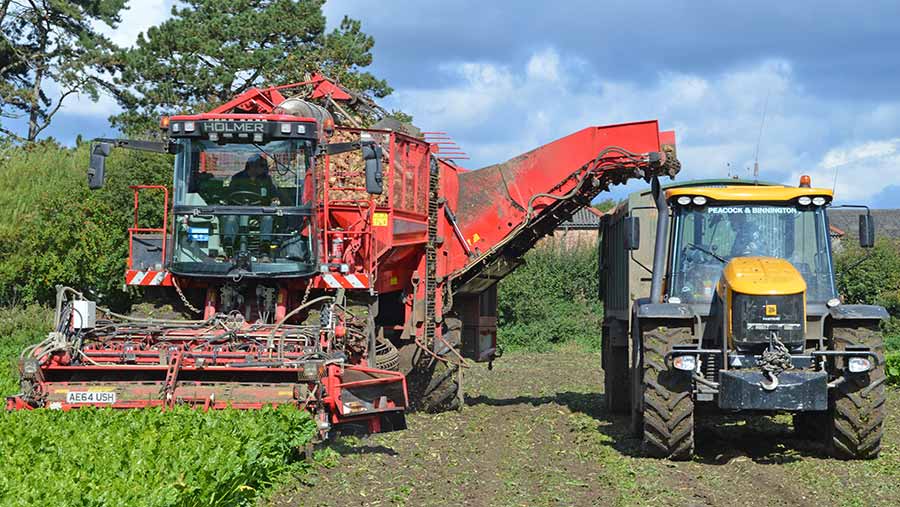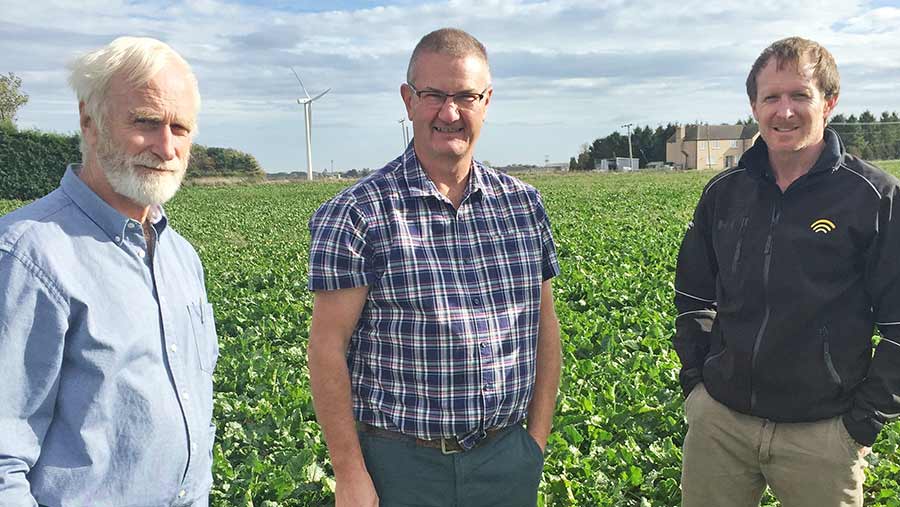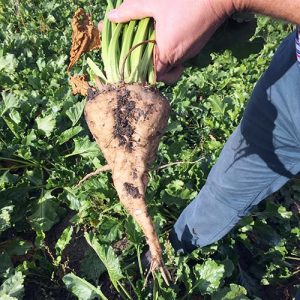Sugar beet grower upbeat on yields despite dry summer

Cambridgeshire sugar beet grower Guy Wakeham is aiming for an ambitious yield target of 100t/ha – although his crop has to be lifted relatively early, by the end of November.
His focus is to improve sugar beet production and optimise the crop’s potential, whatever the weather may bring (such as this summer’s drought).
He has 40ha of beet in the ground at Petary Ltd near Chatteris, in a rotation that includes wheat, combining peas and occasional linseed. Lifting will be completed in November so that winter wheat can be drilled afterwards.
See also: How to manage disease in sugar beet crops
Farm facts
- 245ha at Doddington, Chatteris
- Cropping includes winter wheat, sugar beet and combining peas
- Land let for potatoes
- Power and field operations provided by neighbouring farmer
Yield progress
Steady progress has been made with sugar beet yields. The five-year average of 79t/ha was exceeded in 2016 when the crop averaged 85t/ha, while last year’s exceptional summer growing conditions saw yields rise to 88t/ha.
This year, in sharp contrast, the late spring and dry summer have been doubly challenging, says Mr Wakeham, although he acknowledges that his Fenland farm does benefit from moisture-retentive clay loam soils.
“One of the things we will learn this year will be how well our beet manages with a lack of moisture. The crop canopy has been noticeably shorter, but we haven’t seen excessive wilting,” he says.
Mr Wakeham hopes that being one of the 15 participants in Bayer’s #Beet150 yield competition will give him more insight into growing sugar beet, as well as a better understanding of how other growers are overcoming crop challenges.
Predicted harvest yield
Already, he has had plant counts and yield digs done by the Bayer team, with disease scores due to take place shortly and harvester testing planned.
The yield digs, which took place at the start of September, indicate that the crop will yield 87t/ha, reveals Bayer’s Sam Harvey – a very respectable result, given the weather conditions, and well above the average of the #Beet150 group.
“Across the group, the adjusted average from test digs is 65t/ha. It’s about 10-15% down on where crops usually are,” Mr Harvey says.
Crops being grown on light, sandy soils have been the most affected, with those in the drier eastern areas on free-draining ground showing their vulnerability to moisture stress.
“Where crops have managed to hang on to sufficient leaf cover, sugars are likely to be better,” comments independent crop consultant Mike May. “If they have wilted badly, sugars will have been affected.”

Mike May, Guy Wakeham and Sam Harvey
Harvest losses
Mr Wakeham’s attention is now turning to the harvesting operation, as ground conditions and variation in beet shape and size could increase losses.
“The harvester driver will be key this year. We need to minimise root breakages and damage in the dry conditions. The target is to keep losses below 5%, which on our expected production is just over 4t/ha,” he says.
There is no doubt that an even crop is easier to recover and flows through the harvester better, so he is keen to reduce any gaps that occur in the crop at establishment.
“We have a high pest burden in these organic soils. For that reason, we drill at 1.3 units, which is a bit higher than BBRO advice,” he adds.
There are no plans to reduce seed rates, as he stresses that the crop has only one chance of establishing and highlights that the neonicotinoid seed treatments won’t be available next spring.
“We will have to wait and see if that has a plant population effect. Vigour will be key, so we won’t rush to get the crop in the ground,” he says.
Mr May points out that Mr Wakeham can make use of Force (tefluthrin) on the seed in 2019, so soil pests will still be controlled.
“Aphids are another matter, and much will depend on the winter and their survival,” he adds.
Crop agronomy
Sugar beet drilling at Petary Ltd didn’t take place until April 23 this year, some three weeks later than Mr Wakeham’s preferred early April start.
“By the time it did go in, soil temperatures were about 12°C, so it was up and away quickly. In a normal year, I wait for a soil temperature of 7°C and above,” he says.
He has three varieties in the ground: BTS860, Degas and Landon – the last of which has since been withdrawn by the breeder because of bolting. Plant counts showed 104,000 established plants per hectare, which is just above the critical level and higher than the average for the competition group.
A comprehensive weed control programme was used, with three herbicide applications plus oil being made in three weeks.
“The oil can make them a bit ‘hot’, but I am prepared to sacrifice a bit of yield to get good weed control,” Mr Wakeham says.
Fungicide use has varied this year, with some fields getting two applications and others only one, depending on lifting date. BBRO advice on spray timing was followed and he waited for disease to show before making the first application, on August 15.
“With hindsight, I wish I had gone a bit earlier, even though disease levels are low. The active ingredients in Escolta (cyproconazole + trifloxystrobin) aren’t curative,” he adds.
Mr Harvey points out that BBRO work indicates an 11-12t/ha yield lift from using two fungicide sprays rather than one, although he admits that 2018 was the right year to try using just one.
“Escolta has a short harvest interval of 21 days, so it can be used in a two-spray programme without any implications for harvest date,” he says.
Sugar beet contest
 Bayer’s sugar beet yield competition is open to all growers of the crop across British Sugar’s four factory areas.
Bayer’s sugar beet yield competition is open to all growers of the crop across British Sugar’s four factory areas.
The eventual winner – decided by the highest-yielding field harvested by the end of November – will get the chance to join a study tour to Chile, to learn more about Barbara Becker’s success in achieving the world sugar beet record of 196.7t/ha.
The competing growers are keen to fine-tune their crop management and develop techniques to get the most from their sugar beet.

